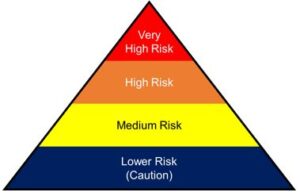
OSHA Depiction of COVID Risk Categories
Just how far are we expected to go with our workplace protections to prevent the spread of COVID-19? OSHA expects us to have protective measures place. However, the extent of our preventive measures needs to be appropriate to match the assessed risks, not necessarily the best of the best practices available in all cases.
A little clarification on the categories in the Risk Pyramid:
- Very High Exposure Risk: Jobs with a very high potential for exposure to known or suspected sources of SARS-CoV-2 during specific medical, postmortem, or laboratory procedures.
- High Exposure Risk: Jobs with a high potential for exposure to known or suspected sources of SARS-CoV-2. Workers in this category include:
- Medium Exposure Risk: Jobs that require frequent/close contact with people who may be infected, but who are not known to have or suspected of having COVID-19.
- Lower Exposure Risk (Caution): Jobs that do not require contact with people known to be, or suspected of being, infected with SARS-CoV-2. Workers in this category have minimal occupational contact with the public and other coworkers
I'm personally relieved that my work and the work of most client companies' situations are mostly in the section with "Lower Exposure Risk". However, we may occasionally find ourselves in a "Medium Risk" situation, especially as managers in production plants.
Since our risk of exposures is not extreme, our preventive measures tend to be simple and inexpensive. However, there are many companies that have not put forth the effort to but very basic common controls in place in a consistent manner yet.
If your company has been lax on basic COVID-19 controls (or any other controls required by your county), I suggest you revisit your current program and invest more effort in protecting employees. This is a listing of items to consider:
- Require masks (cleaned cloth or newish non-woven) at all times inside (except when a worker is in their own workstation and it is more than 10 ft from the next worker). Mask required back on if someone walks in the workstation within 6 ft of the worker.
- If the number of sinks in the plant is not high, supply large hand sanitizer containers at workstations, or by aisles in each area of the plant.
- Communicate clearly on COVID-19 procedures and expectations, including mask use, hand washing, coughing & sneezing etiquette.
- Where workers need to be closer than 6 ft apart to run jobs, install barrier walls (corrugated, form board, or plexi are OK).
- Create 6 ft distancing for break rooms, meeting rooms, training classes (outside may be safer when the weather is bearable). Don't let people congregate to chat. Consider Zoom type meetings when many will be needed for an extended meeting.
- Create and manage on-going systems to sanitize shared surfaces regularly (examples: hand tools, control panels, forklift controls/steering wheel, conference table, sink handles, refrigerator handles, coffee pot handles, restroom doors, ...).
- Have a COVID-19 check-in screening process for employees, truckers, and other visitors.
- Some companies may want to consider splitting crews (to multiple shifts) to help create distancing in the plant.
The CDC has created a document that has many more ideas on COVID-19 preventive measures for manufacturing companies. You can check it out at this link:
https://www.cdc.gov/coronavirus/2019-ncov/community/guidance-manufacturing-workers-employers.html

